2018 MERCEDES-BENZ S-CLASS SEDAN ECU
[x] Cancel search: ECUPage 125 of 562

Vehicles with electrically adjus table outer seatsVe hicles with individual rear seats
#Ve hicles with a rear ben chseat or electri‐
cally adjustable outer seats: Fold down the
re ar armrest.
#Pull handle 1and fold down co ver2.
Pa rcel net hooks
Obser vethefo llowing no tes:
RSecure the load using the parcel net hooks.
RDo not use elastic stra ps or nets tosecure a
load. These are intended only as anti-slip pro‐
te ction for light loads.
RDo not route tie downs across sharp edges
or co rners.
RPa d sharp edges for pr otection.
There are up tofour parcel net hooks in the
trunk depending on the equipment ins talled.
Seats and stowing 12
3
Page 127 of 562

&WARNING Risk of becoming trapped
when pressing the EA SY-PAC K trunk box
in
When the EA SY-PACK tr unkboxis pr essed
into there tracted position, your hands may
become tr apped. Childr en,inparticular, may
injure themselves when doing so.
#When pressing the EA SY-PAC K trunk
box in, make sure that your hands are
not within the sweep of the EA SY-PACK
tr unk box.
#When leaving theve hicle, alw aysta ke
th e SmartK eywith you and lock the
ve hicle.
#Ne ver lea vechildren unatte nded inthe
ve hicle.
* NO
TEDama getotheex tended EAS Y-
PA CK tr unkbox
The EA SY-PAC K trunk box may be damage d
when it is extended.
#Do not place any objects on or press
down on the EA SY-PAC K trunk box
frame.
#Do not close the trunk lid when the
EAS Y-PA CK tr unkbox is extended.
* NO
TEDama getothe EA SY-PAC K trunk
box byobjects
Objects which are sharp-edged, pointed,
fragile, rounded or hea vyand objects that
ro ll can damage the EA SY-PAC K trunk box
and be thro wn out.
#Do not transport objects which are
sharp-edged, pointe d,rounded or frag‐
ile and objects that roll in the EA SY-
PA CK tr unk box.
#Alwaysstow and secure such objects
outside of the box in the trunk.
#Alw ays obser vethe maximum permitted
load of the EA SY-PAC K trunk box.
#Do not use the EA SY-PAC K trunk box
when there ar seats are folded for‐
wa rds.
The maximum permissible load of the EA SY-
PA CK tr unk box is22 lbs (10 kg).To preve ntthe
box from being overloaded, the box floor lo wers
onto the trunk floor when the load reaches
appr oximately 11lbs (5 kg).
#To remo ve:pull handle 2ofthe box.
Seats and stowing 12
5
Page 131 of 562
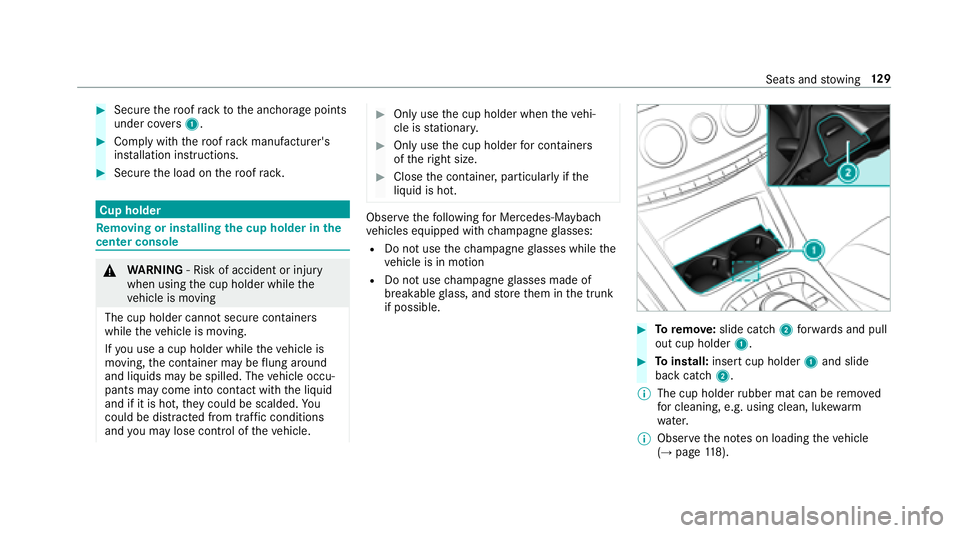
#Securethero of rack tothe anchorage points
under co vers 1.
#Com plywit hth ero of rack manufacturer's
ins tallation instructions.
#Secure the load on thero of rack .
Cup holder
Re moving or in stalling the cup holder in the
center console
& WARNING ‑ Risk of accident or injury
when using the cup holder while the
ve hicle is moving
The cup holder cannot secure containers
while theve hicle is moving.
If yo u use a cup holder whiletheve hicle is
moving, the conta iner may be flung around
and liquids maybe spill ed. The vehicle occu‐
pants may come into contact with the liquid
and if it is hot, they could be scalded. You
could be dist racted from traf fic conditions
and you may lose cont rol of theve hicle.
#Only use the cup holder when theve hi‐
cle is stationar y.
#Only use the cup holder for containers
of theright size.
#Close the conta iner, particular lyifth e
liquid is hot.
Obser vethefo llowing for Mercedes-Mayba ch
ve hicles equipped with champagne glasses:
RDo not use thech ampagne glasses while the
ve hicle is in motion
RDo not use champagne glasses made of
breakable glass, and store them in the trunk
if possible.
#To remo ve:slide catch 2forw ards and pull
out cup holder 1.
#Toinstall: insert cup holder 1and slide
back catch 2.
% The cup holder rubber mat can be remo ved
fo r cleaning, e.g. using clean, luk ewarm
wate r.
% Obser vethe no tes on loading theve hicle
(
→page 118).
Seats and stowing 12
9
Page 141 of 562
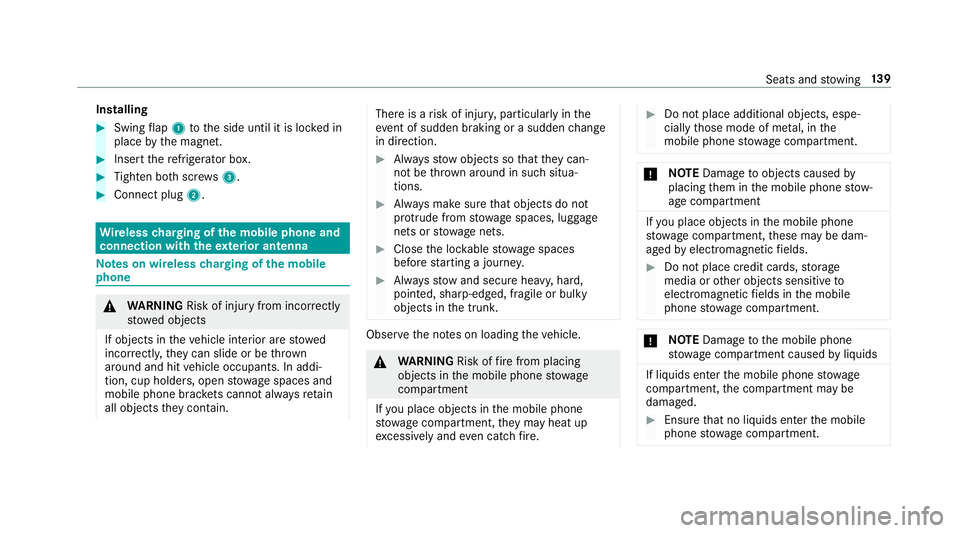
Installing
#Swingflap 1 tothe side until it is loc ked in
place bythe magnet.
#Insert there frigerator box.
#Tighten bo thscr ews3.
#Connect plug 2.
Wirelesscharging of the mobile phone and
connection with theex terior antenna
Note s on wireless charging of the mobile
phone
& WARNING Risk of injury from incorrectly
stowe d objects
If objects in theve hicle interior are stowed
incor rectly, they can slide or be throw n
around and hit vehicle occupants. In addi‐
tion, cup holders, open stowage spaces and
mobile phone brac kets cann otalw aysre tain
all objects they contain.
There is arisk of injur y,particularly in the
ev ent of sudden braking or a sudden change
in direction.
#Alw aysstow objects so that they can‐
not be throw n around in such situa‐
tions.
#Alw ays make sure that objects do not
pr otru de from stowage spaces, luggage
nets or stowage nets.
#Close the loc kable stow age spaces
before starting a journe y.
#Alwaysstow and secure heavy, hard,
pointe d, sharp-edged, fragile or bulky
objects in the trunk.
Obser vethe no tes on loading theve hicle.
&
WARNING Risk offire from placing
objects in the mobile phone stowage
compartment
If yo u place objects in the mobile phone
stow age compartment, they may heat up
exc essively and even catch fire .
#Do not place additional objects, espe‐
cially those mode of me tal, in the
mobile phone stowage compartment.
* NO
TEDama getoobjects caused by
placing them in the mobile phone stow‐
age compartment
If yo u place objects in the mobile phone
stow age compartment, these may be dam‐
aged byelectromagnetic fields.
#Do not place credit cards, storage
media or other objects sensitive to
electromagnetic fields in the mobile
phone stowage compartment.
* NO
TEDama getothe mobile phone
stow age compartment caused byliquids
If liquids enter the mobile phone stowage
compartment, the compartment may be
damaged.
#Ensure that no liquids enter the mobile
phone stowage compartment.
Seats and stowing 13
9
Page 143 of 562
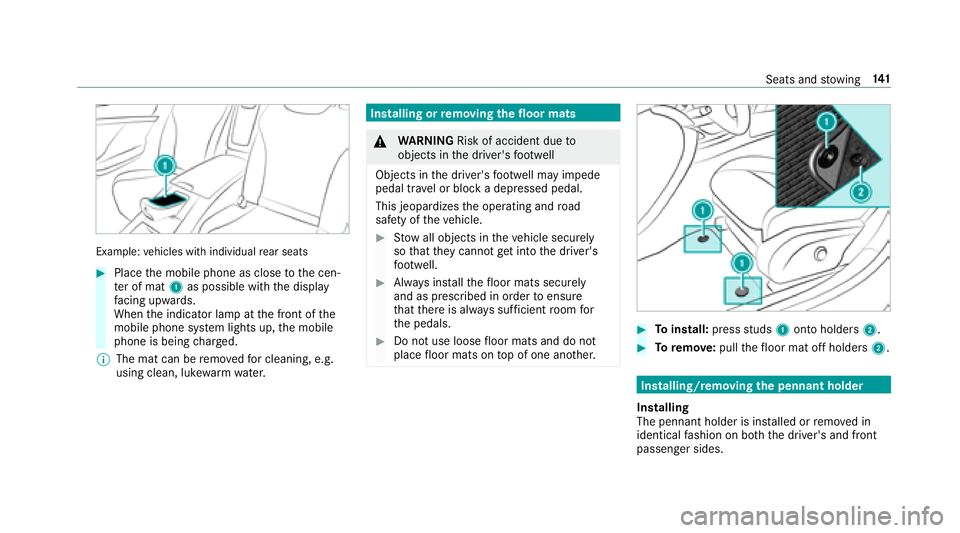
Example:vehicles with individual rear seats
#Place the mobile phone as close tothe cen‐
te r of mat 1as possible with the display
fa cing up wards.
When the indicator lamp at the front of the
mobile phone sy stem lights up, the mobile
phone is being charge d.
% The mat can be remo vedfo r cleaning, e.g.
using clean, luk ewarmwate r.
Installing or removing the floor mats
&
WARNING Risk of accident due to
objects in the driver's foot we ll
Objects in the driver's foot we ll may impede
pedal tr avel or block a depressed pedal.
This jeopardizes the operating and road
saf etyof theve hicle.
#Stow all objects in theve hicle securely
so that they cannot getinto the driver's
fo ot we ll.
#Alw ays ins tallth efloor mats securely
and as prescribed in order toensure
th at there is alw ays suf ficient room for
th e pedals.
#Do not use loose floor mats and do not
place floor mats on top of one ano ther.#To install: pressstuds 1onto holders 2.
#Toremo ve:pull thefloor mat off holders 2.
Installing/removing the pennant holder
Installing
The pennant holder is ins talled or remo ved in
identical fashion on bo th the driver's and front
passenger sides.
Seats and stowing 14
1
Page 169 of 562
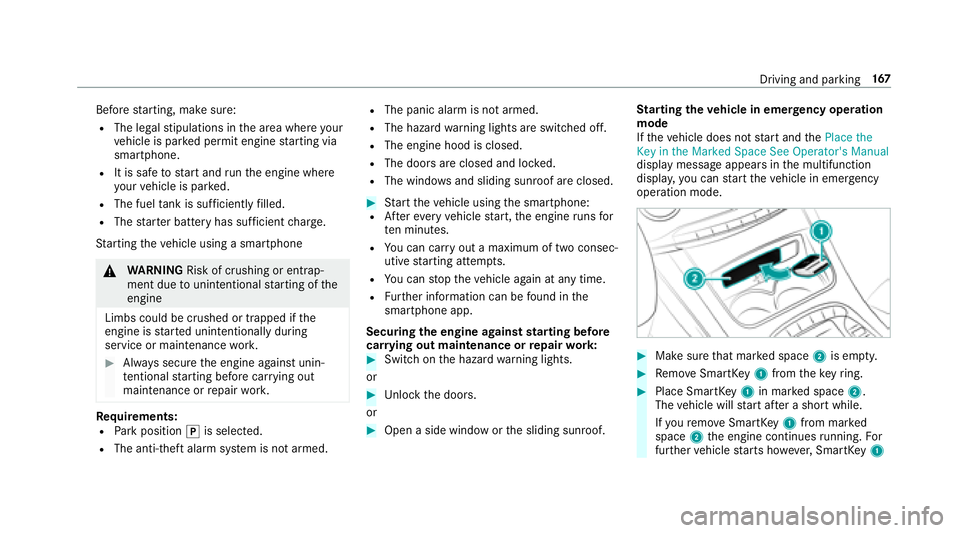
Beforestarting, make sure:
RThe legal stipulations in the area where your
ve hicle is par ked permit engine starting via
smartphone.
RIt is safe tostart and runth e engine where
yo ur vehicle is par ked.
RThe fuel tank is suff icientlyfilled.
RThe star ter battery has suf ficient charge .
St arting theve hicle using a smartphone
&
WARNING Risk of crushing or entrap‐
ment due tounin tentional starting of the
engine
Limbs could be crushed or trapped if the
engine is star ted unintentionally during
service or maintenance work.
#Alw ays secure the engine against unin‐
te ntional starting before car rying out
maintenance or repair work.
Re quirements:RPark position jis selected.
RThe anti- theft alarm sy stem is not armed.
RThe panic alarm is not armed.
RThe hazard warning lights are switched off.
RThe engine hood is closed.
RThe doors are closed and loc ked.
RThe windo wsand sliding sunro of are closed.
#Start theve hicle using the smartphone:RAf tereve ryvehicle start, the engine runs for
te n minu tes.
RYo u can car ryout a maximum of two consec‐
utive starting attem pts.
RYo u can stop theve hicle again at any time.
RFu rther information can be found in the
smartphone app.
Securing the engine against starting before
car rying out maintenance or repair work:
#Switch on the hazard warning lights.
or
#Un lock the doors.
or
#Open a side window or the sliding sunroof. St
arting theve hicle in emer gency operation
mode
If th eve hicle does not start and the�3�O�D�F�H �W�K�H
�.�H�\ �L�Q �W�K�H �0�D�U�N�H�G �6�S�D�F�H �6�H�H �2�S�H�U�D�W�R�U�
�V �0�D�Q�X�D�O
display message appears in the multifunction
displa y,yo u can start theve hicle in emer gency
operation mode.
#Make surethat mar ked space 2is em pty.
#Re mo veSmartK ey1 from theke yring.
#Place Smart Key1 in mar ked space 2.
The vehicle will start af ter a short while.
If yo ure mo veSmartK ey1 from mar ked
space 2the engine continues running. For
fur ther vehicle starts ho wever,SmartK ey1
Driving and pa rking 16
7
Page 170 of 562

must be located in marked space 2during
th e entire journe y.
#Have SmartK ey1 checked at a qualified
specialist workshop.
If th eve hicle does not star t:
#Lea veSmartK ey1 in mar ked space 2.
#Depress the brake pedal and start theve hicle
using thest art/ stop button.
% You can also switchon the po wer supp lyor
th e ignition with thest art/ stop button.
Breaking-in no tes
Mercedes-AMG vehicles: observeth e no tes in
th e Supplement. Otherwise, you may not recog‐
nize dangers.
To preser vethe engine during thefirs t
1, 000 miles (1,500 km):
RDrive at varying road speeds and engine
speeds.
RDrive in drive program Cor E.
RChange ge ar beforetheta ch ome ter needle is
Ô ofthewa yto there d area of theta ch ome‐
te r.
RDo not shi ftdown a gear manually in order to
brake.
RAv oid overstraining theve hicle, e.g. driving at
full thro ttle.
RDo not depress the accelera tor pedal be yond
th e pressure point (kickdown).
ROnly increase the engine speed gradually and
accelera tetheve hicle tofull speed af ter
1, 000 miles (1,500 km).
This also applies when the engine or parts of the
driv etra in ha vebeen replaced.
Please also obser vethefo llowing breaking-in
no tes:
RIn cer tain driving and driving saf etysy stems,
th e sensors adjust automatically while a cer‐
ta in dis tance is driven af terth eve hicle has
been delivered or af terre pairs. Full sy stem
ef fectiveness is not achie ved until the end of
th is teach-in process.
RBrake linings, brake discs and tires that are
either new or ha vebeen replaced only ach‐
ie ve optimum braking ef fect and gri
p af
ter
se veral hundred kilom eters of driving. Com‐
pensate forth ere duced braking ef fect by
applying greater forc eto the brake pedal.
Note s on driving
&
WARNING Risk of accident due to
objects in the driver's foot we ll
Objects in the driver's foot we ll may impede
pedal tra vel or block a depressed pedal.
This jeopardizes the operating and road
saf etyof theve hicle.
#Stow all objects in theve hicle securely
so that they cannot getinto the driver's
fo ot we ll.
#Ensure floor mats and carpets cannot
slip and pr ovide suf ficient room forth e
pedals.
#Do not lay multiple floor mats or car‐
pets on top of one ano ther.
16 8
Driving and pa rking
Page 182 of 562
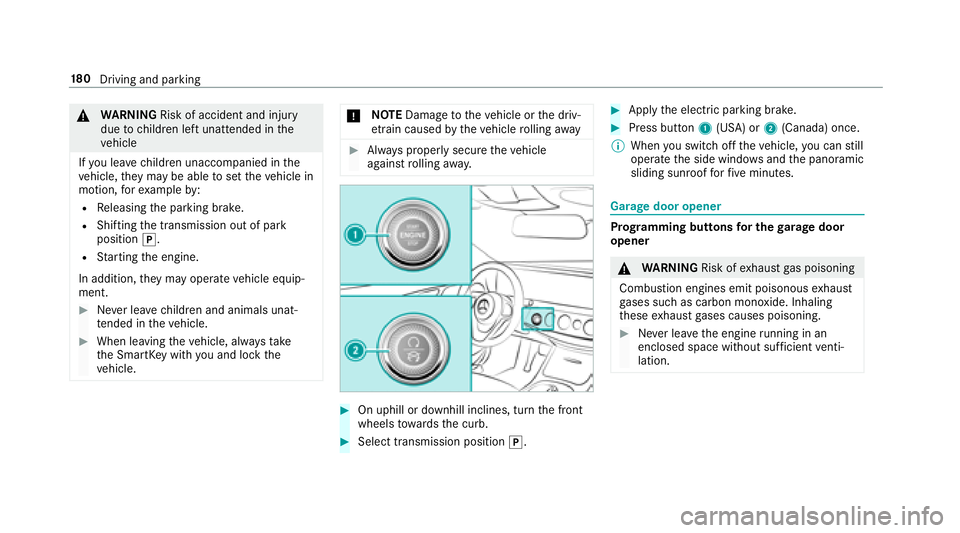
&WARNING Risk of accident and injury
due tochildren left unatte nded inthe
ve hicle
If yo u lea vechildren unaccompanied in the
ve hicle, they may be able toset theve hicle in
motion, forex ample by:
RRe leasing the parking brake.
RShifting the transmission out of park
position j.
RStarting the engine.
In addition, they may operate vehicle equip‐
ment.
#Ne ver lea vechildren and animals unat‐
te nded in theve hicle.
#When leaving theve hicle, alw aysta ke
th e SmartK eywith you and lock the
ve hicle.
* NO
TEDama getotheve hicle or the driv‐
et ra in caused bytheve hicle rolling away
#Alw ays proper lysecure theve hicle
against rolling away.
#On uphill or downhill inclines, turn the front
wheels towa rdsth e curb.
#Select transmission position j.
#Applythe electric parking brake.
#Press button 1(USA) or 2(Canada) once.
% When you switch offtheve hicle, you can still
opera tethe side windo wsand the panoramic
sliding sunroof forfive minutes.
Garage door opener
Prog ramming buttons for the garage door
opener
& WARNING Risk ofexhaust gas poisoning
Combustion engines emit poisonous exhaust
ga ses such as carbon monoxide. Inhaling
th ese exhaust gases causes poisoning.
#Ne ver lea vethe engine running in an
enclosed space wi thout suf ficient venti‐
lation.
18 0
Driving and pa rking